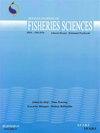波斯湾Qeshm岛珊瑚礁底栖有孔虫群落研究
IF 0.6
4区 农林科学
Q3 FISHERIES
引用次数: 3
摘要
底栖有孔虫在珊瑚礁环境的沉积物生成中很重要,是水质和珊瑚礁健康的良好指标。目前缺乏关于波斯湾珊瑚礁有孔虫动物群的准确信息。在这项研究中,2019年6月在纳兹岛和泽顿公园的两个珊瑚站进行了沉积物采样。使用小型取芯器收集每个位置重复三次的表面沉积物,然后将其固定在70%乙醇中。本研究根据有孔虫的形态特征,共鉴定出有孔虫群落19科23属30种。我们的结果表明,两个采样点的有孔虫群落相似。Quinqueoculina属是纳兹岛和泽顿公园最丰富的属。泽顿公园的Foraminifer频率高于纳兹岛。就在Zeytoon公园发现了共生有孔虫(如Peneroplis)。更高的频率和共生有孔虫的存在可能表明泽顿公园未来有更有利的珊瑚礁生长条件。最后,我们建议有孔虫群落的结构可以用作珊瑚礁周围水质的预警系统,特别是可以帮助资源管理者就保护珊瑚栖息地做出更好的决定。本文章由计算机程序翻译,如有差异,请以英文原文为准。
Study of coral reef benthic foraminiferal assemblages in Qeshm Island, Persian Gulf
Benthic foraminifera are important in sediment production of coral reef environments and are excellent indicators of water quality and reef health. There is a lack of precise information about the foraminifer’s fauna of the coral reefs in the Persian Gulf. In this study, sediment sampling was performed in June 2019 from two coral stations of Naz Island and Zeytoon Park. The surface sediment with three replicates for each location was collected using a mini corer and then were fixed in 70% ethanol. In this study, thirty species belong to 23 genera and 19 families of foraminifer's assemblages were identified based on morphological characters. Our results indicated that Foraminiferal assemblages were similar in both sampling localities. Quinqueloculina was the most abundant genera for both Naz Island and Zeytoon Park. Foraminifer's frequency of Zeytoon Park was higher than Naz Island. Symbiont-bearing foraminifera (e.g. Peneroplis) were observed just in Zeytoon Park. Higher frequency and the presence of symbiont-bearing foraminifera possibly indicate that Zeytoon Park has a more favorable condition for the coral reef growth in the future. Finally, we recommend that the structure of the foraminifer’s community could be used as an early warning system for water quality around coral reefs and in particular, would help resource managers make better decisions about protecting coral habitats.
求助全文
通过发布文献求助,成功后即可免费获取论文全文。
去求助
来源期刊

Iranian Journal of Fisheries Sciences
FISHERIES-
CiteScore
2.30
自引率
11.10%
发文量
0
审稿时长
3 months
期刊介绍:
1- Living various species (contains animals and vegetal species) in various aquatic ecosystems.
2- Health and diseases of aquatic species.
3- Determining the stocks and specific time and location for catching and reliable exploitation for sustainable development.
4- Methods of propagation and culture of high value aquatic resources.
5- Aquatic stock assessment and the methods of restocking the high value species and suggestion for rate, areas and the time for releasing fish and other aquatic organisms fries.
6- Pollutant agents and their effects to the environments of aquatic species.
7- Feed and feeding in aquatic organisms.
8- Fish processing and producing new products.
9- The economic and social aspects of fisheries.
 求助内容:
求助内容: 应助结果提醒方式:
应助结果提醒方式:


